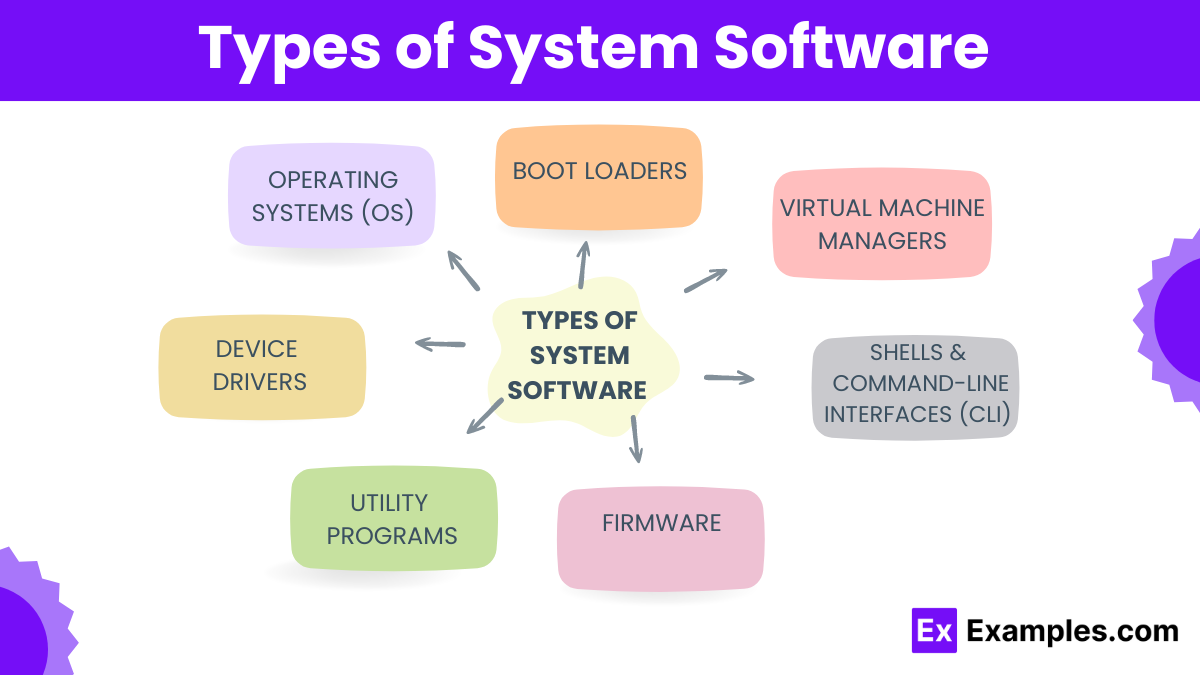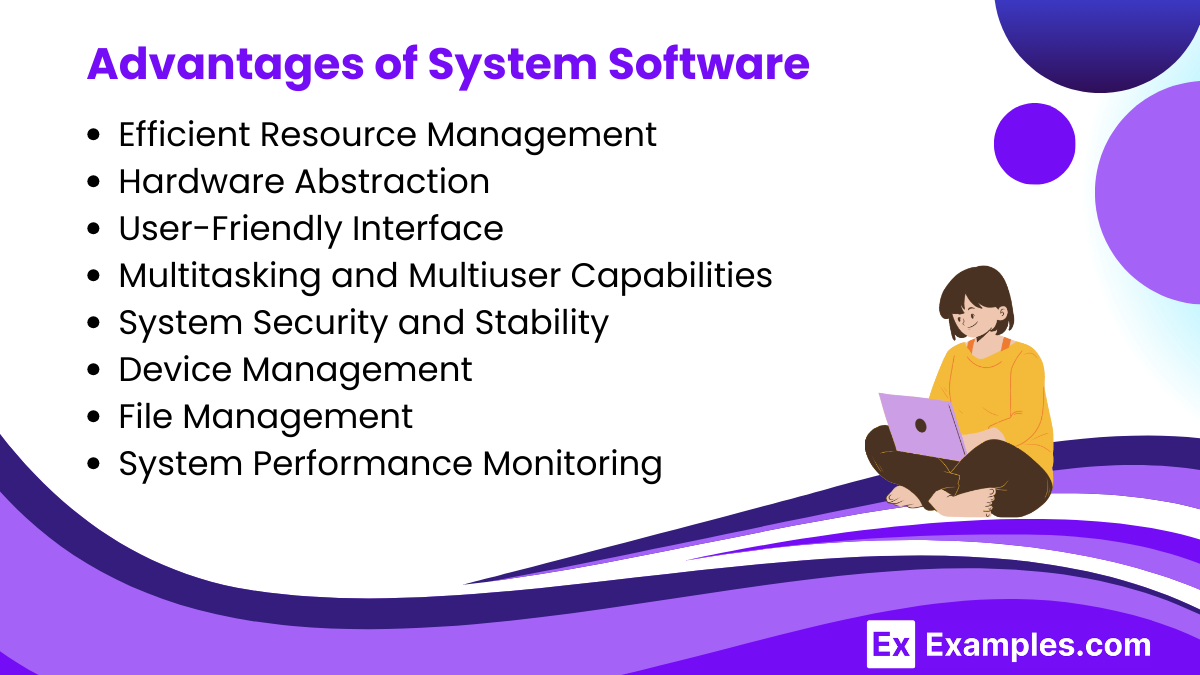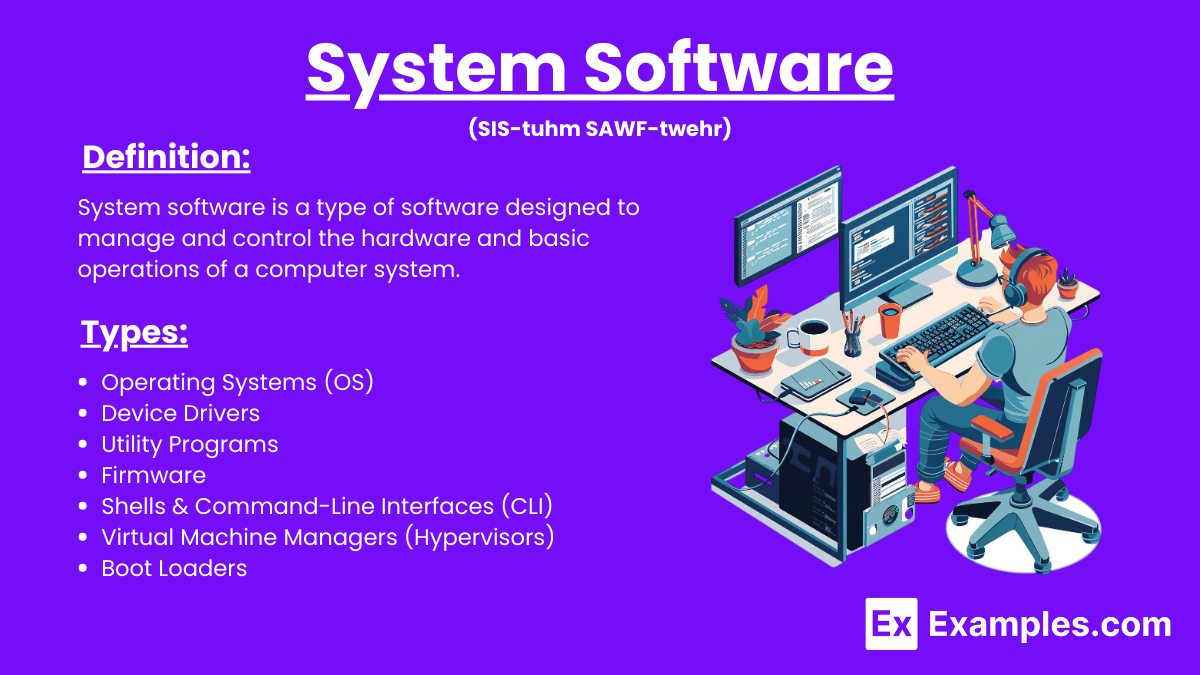System Software – Examples, Definition, Types, Advantages
System software is a type of computer software designed to provide a platform for other software. It manages and controls the hardware components of a computer system and provides a foundation for running application software. System software facilitates the basic functions of the computer, ensuring that the hardware operates efficiently and that application software can perform tasks effectively.
What is System Software?
System software is a type of software designed to manage and control the hardware and basic operations of a computer system. It acts as a bridge between the computer hardware and the application software, ensuring that all components of a computer work together smoothly.
Examples of System Software
Operating Systems: These are the primary type of system software, managing all other software and hardware on a computer.
- Windows: A widely used operating system developed by Microsoft, known for its user-friendly interface and compatibility with a wide range of software applications.
- macOS: The operating system for Apple’s Macintosh computers, known for its sleek design and seamless integration with other Apple products.
- Linux: An open-source operating system that comes in various distributions (distros) such as Ubuntu, Fedora, and Debian, widely used for servers, desktops, and embedded systems.
- Unix: A powerful, multiuser operating system primarily used in servers, workstations, and advanced computing environments.
Device Drivers: These specialized programs allow the operating system to communicate with hardware devices, ensuring proper functionality.
- NVIDIA Graphics Drivers: Enable communication between the operating system and NVIDIA graphics cards, allowing for high-performance graphics processing.
- Realtek HD Audio Drivers: Facilitate the operation of Realtek a hardware, ensuring high-quality sound output.
- Printer Drivers: Enable communication between the computer and printer, allowing for accurate printing of documents.
Utility Software: These programs perform maintenance tasks to ensure the proper operation of the computer system.
- Antivirus Software: Programs like Norton and McAfee that detect and remove malware, protecting the system from security threats.
- Disk Cleanup Tools: Utilities such as CCleaner that help free up disk space by removing unnecessary files and optimizing system performance.
- Backup Software: Programs like Acronis True Image and Backup Exec that create copies of data to prevent loss in case of system failure.
Firmware: Software programmed into read-only memory, providing low-level control for a device’s specific hardware.
- BIOS (Basic Input/Output System): Firmware used to perform hardware initialization during the booting process and to provide runtime services for operating systems and programs.
- UEFI (Unified Extensible Firmware Interface): A modern replacement for BIOS, offering faster startup times, support for larger hard drives, and enhanced security features.
System Utilities: These tools help manage, maintain, and control computer resources and performance.
- File Management Tools: Programs like File Explorer (Windows) and Finder (macOS) that help users manage files and directories on their systems.
- Task Managers: Tools such as Windows Task Manager and macOS Activity Monitor that allow users to monitor and control running processes and system performance.
- System Monitors: Utilities like Resource Monitor (Windows) and iStat Menus (macOS) that provide detailed information about system resources and usage.
Language Translators: Software that translates high-level programming languages into machine code.
- Compilers: Convert high-level code (e.g., C++, Java) into machine code that can be executed by the computer’s processor.
- Interpreters: Execute high-level code directly, translating it into machine code line by line (e.g., Python, Ruby).
- Assemblers: Convert assembly language code into machine code.
Features of System Software
System software is essential for managing and operating a computer system. It provides a platform for running application software and ensures efficient and effective use of the hardware. Key features of system software include:
- Hardware Management: System software controls and manages the computer’s hardware components, such as the CPU, memory, disk drives, and peripheral devices. It ensures that these components function correctly and efficiently.
- Operating System: The operating system (OS) is the core system software that manages all other software and hardware on a computer. It provides a user interface and handles system resources. Examples include Windows, macOS, and Linux.
- Device Drivers: Device drivers are specialized programs that allow the operating system to communicate with hardware devices like printers, graphics cards, and network adapters. They translate the OS commands into actions that the hardware can perform.
- Utility Programs: Utility programs perform maintenance tasks that help optimize and manage the computer system. These include antivirus software, disk cleanup tools, backup software, and system monitoring tools.
- File Management: System software provides file management capabilities, allowing users to create, delete, move, and manage files and directories. It also handles file permissions and access control.
- Memory Management: Efficient memory management is a critical feature, ensuring that applications have sufficient memory to run and that the system uses available memory effectively. This includes managing the allocation and deallocation of memory.
- Process Management: System software manages the execution of processes, including process scheduling, creation, termination, and synchronization. It ensures that multiple processes can run concurrently without conflicts.
- Security and Access Control: Security features protect the system from unauthorized access and threats. This includes user authentication, access controls, encryption, and security updates to protect against vulnerabilities.
- User Interface: System software provides a user interface, which can be a command-line interface (CLI) or a graphical user interface (GUI). This allows users to interact with the computer and execute commands.
- Network Management: Network management capabilities enable the computer to connect to and communicate over a network. This includes managing network connections, configuring network settings, and handling network security.
Types of System Software

1. Operating Systems (OS)
Operating systems are the core software that manage all other software and hardware on a computer. They provide a user interface and handle essential tasks such as memory management, process scheduling, and file management. Examples include:
- Windows
- macOS
- Linux
- Unix
2. Device Drivers
Device drivers are specialized programs that allow the operating system to communicate with hardware devices. They translate OS commands into actions that the hardware can perform. Examples include drivers for:
- Printers
- Graphics cards
- Network adapters
- Sound cards
3. Utility Programs
Utility programs perform maintenance and optimization tasks to ensure the computer system runs efficiently. They often include tools for:
- Disk Cleanup: Removes unnecessary files to free up space.
- Antivirus Software: Protects against malware and viruses.
- Backup Software: Creates copies of data for recovery purposes.
- System Monitoring Tools: Tracks system performance and resource usage.
4. Firmware
Firmware is a type of low-level software embedded in hardware devices. It provides control and basic functionality for the hardware. Unlike other software, firmware is stored in non-volatile memory (e.g., ROM) and is essential for the initial startup and operation of the hardware. Examples include:
- BIOS (Basic Input/Output System) in computers
- Firmware in routers and network devices
5. Shells and Command-Line Interfaces (CLI)
Shells and CLIs provide a user interface for interacting with the operating system through text-based commands. They are essential for system administrators and advanced users who need to perform complex tasks. Examples include:
- Bash (Bourne Again Shell) in Unix/Linux
- PowerShell in Windows
6. Virtual Machine Managers (Hypervisors)
Virtual machine managers, or hypervisors, allow multiple operating systems to run concurrently on a single physical machine by managing virtual machines. They are crucial for creating and managing virtualized environments. Examples include:
- VMware ESXi
- Microsoft Hyper-V
- Oracle VM VirtualBox
7. Boot Loaders
Boot loaders are small programs that load the operating system into the computer’s memory when the system is turned on. They are critical for starting the OS. Examples include:
- GRUB (Grand Unified Bootloader) for Linux systems
- Windows Boot Manager
Advantages of System Software

- Efficient Resource Management: System software effectively manages the computer’s hardware resources, including the CPU, memory, disk drives, and peripheral devices. This ensures that resources are allocated efficiently and that multiple applications can run simultaneously without conflicts.
- Hardware Abstraction: System software provides a layer of abstraction between the hardware and application software. This abstraction allows developers to write applications without needing to know the specifics of the underlying hardware, making software development more accessible and portable across different hardware platforms.
- User-Friendly Interface: Operating systems, a type of system software, offer graphical user interfaces (GUIs) that make computers easier to use. These interfaces allow users to interact with the system through visual elements like windows, icons, and menus, simplifying tasks such as file management and system configuration.
- Multitasking and Multiuser Capabilities: System software supports multitasking, allowing multiple applications to run concurrently, and multiuser environments, enabling multiple users to share the same system resources securely and efficiently. This is essential for both personal computing and enterprise environments.
- System Security and Stability: System software includes security features that protect the system from malware, unauthorized access, and other security threats. It also ensures system stability by managing system crashes and errors, providing a reliable environment for applications to run.
- Device Management: System software includes device drivers that facilitate communication between the operating system and hardware devices. This allows the operating system to control and use various hardware components such as printers, graphics cards, and network adapters effectively.
- File Management: System software provides file management capabilities, organizing data into files and directories, and offering tools for creating, deleting, copying, moving, and managing files. This organization is crucial for maintaining order and easy access to data.
- System Performance Monitoring: System software includes utilities that monitor system performance, providing insights into CPU usage, memory allocation, disk usage, and network activity. These tools help users and administrators optimize system performance and troubleshoot issues.
Disadvantages of System Software

- Complexity: System software, especially operating systems, can be highly complex. This complexity can make it difficult for users to understand and configure the software, requiring a steep learning curve and sometimes specialized knowledge.
- Resource Intensive: System software often requires significant system resources to operate efficiently. This includes CPU power, memory, and storage space. On older or less powerful hardware, system software can slow down system performance and reduce efficiency.
- Compatibility Issues: Different system software might not be compatible with all hardware or peripheral devices. Users may encounter problems when trying to run system software on older or less common hardware configurations, leading to hardware-software compatibility issues.
- Cost: Some system software, particularly commercial operating systems like Microsoft Windows, can be expensive. Licensing fees for operating systems and other system software can add up, especially for businesses that need to install the software on multiple machines.
- Security Vulnerabilities: System software can be a target for cyberattacks. Operating systems and other critical system software are often targeted by malware, viruses, and other security threats. Keeping system software secure requires regular updates and patches, which can be inconvenient.
- Updates and Maintenance: System software requires regular updates to fix bugs, patch security vulnerabilities, and improve functionality. These updates can be disruptive, requiring system reboots and potentially causing compatibility issues with other software.
- Limited Customization: Users may find that system software offers limited customization options. While some advanced users can modify system software to better meet their needs, this often requires technical expertise and can risk system stability.
- Vendor Lock-In: Relying on a particular vendor’s system software can lead to vendor lock-in. This makes it difficult for users to switch to another system or provider without incurring significant costs or compatibility issues.
Uses of System Software
- System Software: Manages hardware and software resources, acting as an intermediary between users and computer hardware to ensure correct execution of commands.
- Hardware Resource Management: Allocates CPU, memory, disk drives, and peripheral devices, ensuring efficient and effective hardware operation.
- File Management: Provides capabilities to create, delete, move, copy, and organize files and directories, maintaining an organized data structure.
- Process Management: Allocates CPU time, memory, and resources, handles multitasking, and optimizes system performance.
- Device Drivers: Includes specialized programs for communication with hardware devices like printers, graphics cards, and network adapters, ensuring correct hardware function.
- System Security: Implements security measures like user authentication, access controls, firewalls, and antivirus programs to protect against unauthorized access and malware.
- Memory Management: Allocates memory space to applications and processes, handling tasks like paging and swapping to ensure efficient memory usage.
- User Interface: Provides interfaces (GUI or CLI) for user interaction with the computer system.
- System Utilities: Includes tools for maintenance tasks like disk cleanup, defragmentation, backups, and software updates to maintain performance and reliability.
- Boot Management: Manages the boot process, initializing hardware and loading the operating system via BIOS or UEFI firmware.
- Network Management: Handles network connections, manages network resources, configures settings, and ensures secure data transmission.
- Software Development: Provides tools for software creation, testing, and debugging, such as compilers, interpreters, and IDEs.
- System Monitoring and Performance Tuning: Includes tools to track performance and resource usage, optimize performance, troubleshoot issues, and ensure smooth operation.
- Virtualization: Manages virtual machines, allowing multiple operating systems to run on a single physical machine, useful for testing, development, and data center resource optimization.
How does an operating system function?
An operating system manages hardware resources, provides a user interface, and enables applications to run.
What is the role of device drivers?
Device drivers allow the operating system to communicate with hardware devices, ensuring proper functionality.
Why are utility programs important?
Utility programs perform maintenance tasks, such as file management, virus scanning, and system backups, enhancing computer performance.
What is firmware?
Firmware is specialized software stored in hardware devices, providing low-level control and functionality.
How does system software differ from application software?
System software manages hardware and runs application software, while application software performs specific user tasks.
Why is system software essential?
System software is crucial for managing hardware, running applications, and ensuring the overall functionality of a computer system.
What are examples of popular operating systems?
Popular operating systems include Windows, macOS, Linux, and Android.
How do system updates affect system software?
System updates improve performance, fix bugs, enhance security, and add new features to system software.
What is the boot process in system software?
The boot process initializes hardware, loads the operating system, and prepares the computer for use.
How does system software manage memory?
System software allocates memory to applications, manages memory usage, and prevents conflicts between processes.



